Located about 2300 miles (3680 km) from the nearest continental shore, the Hawaiian Islands are the most isolated group of islands on the planet. The plant and animal life of the Hawaiian archipelago is the result of early, very infrequent colonizations of arriving species and the slow evolution of those species—in isolation from the rest of the world's flora and fauna—over a period of at least 5 million years. As a consequence, Hawai'i is home to a large number of endemic species. The radiation of species described by Charles Darwin in the Galapagos Islands which was critical to the formulation of his theory of evolution is far exceeded in the more isolated Hawaiian Islands.

The moa-nalo are a group of extinct aberrant, goose-like ducks that lived on the larger Hawaiian Islands, except Hawaiʻi itself, in the Pacific. They were the major herbivores on most of these islands until they became extinct after human settlement.
The Oahu thrush or ʻāmaui was a subspecies of the olomaʻo endemic to the island of Oahu. It was the first member of its genus to become extinct, c. 1850. Some taxonomic authorities consider it a distinct species, but the International Ornithological Congress presently classifies it as a subspecies of M. lanaiensis.
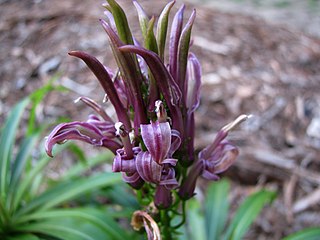
The Hawaiian lobelioids are a group of flowering plants in the bellflower family, Campanulaceae, subfamily Lobelioideae, all of which are endemic to the Hawaiian Islands. This is the largest plant radiation in the Hawaiian Islands, and indeed the largest on any island archipelago, with over 125 species. The six genera involved can be broadly separated based on growth habit: Clermontia are typically branched shrubs or small trees, up to 7 metres (23 ft) tall, with fleshy fruits; Cyanea and Delissea are typically unbranched or branching only at the base, with a cluster of relatively broad leaves at the apex and fleshy fruits; Lobelia and Trematolobelia have long thin leaves down a single, non-woody stem and capsular fruits with wind-dispersed seeds; and the peculiar Brighamia have a short, thick stem with a dense cluster of broad leaves, elongate white flowers, and capsular fruits. The relationships among the genera and sections remains unsettled as of April 2022.
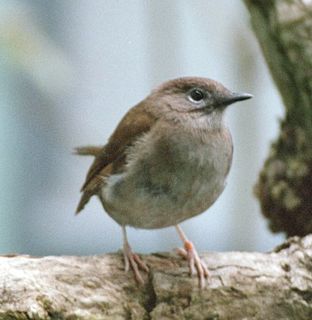
Myadestes is a genus of solitaires, medium-sized mostly insectivorous birds in the thrush family, Turdidae.

Akialoa is an extinct genus of Hawaiian honeycreeper in the subfamily Carduelinae of the family Fringillidae.

The lesser ʻakialoa was a species of finch in the family Fringillidae. It was endemic to the island of Hawaii. It became extinct due to habitat loss. It disappeared at around the same time as its Oahu cousin.

The Kauai ʻakialoa was a Hawaiian honeycreeper in the subfamily Carduelinae of the family Fringillidae. It was endemic to the island of Kauai, Hawaii. It became extinct in the 20th century due to introduced avian disease and habitat loss. The Kauai ʻakialoa was about seven and a half inches in length and had a very long downcurved bill, which covered one third of its length. The adult males were bright olive-yellow on top and yellow on the bottom. The throat, breast, and sides of the body were olive-yellow. The females, however, were green-gray above and had a shorter bill.

The Maui ʻalauahio, also known as the Maui Nui ʻalauahio or Maui creeper, is a species of Hawaiian honeycreeper. It is endemic to Maui Nui, Hawaii. The name Maui ʻalauahio is somewhat misleading because the species seems to have occurred on most, if not all, parts of the ancient Maui Nui, which includes the present day islands of Maui, Molokaʻi, Lānaʻi, and Kahoʻolawe. There are two subspecies: the Lānaʻi ʻalauahio, P. montana montana, which occurred on Lānaʻi (extinct); and P. montana newtoni which occurs on Maui. The common name refers to both groups.

The olomaʻo is a small, dark solitaire endemic to Oahu, Maui, Lānaʻi and Molokaʻi in the Hawaiian Islands. It is listed as Critically Endangered or possibly extinct.
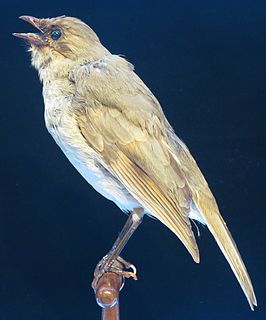
The kāmaʻo or large Kauaʻi thrush was a small, dark solitaire endemic to Kauaʻi in the Hawaiian Islands.

Hemignathini is a formerly-recognized tribe of Hawaiian honeycreepers containing the ʻalauahios, the extinct ʻakialoas, ʻamakihis, and extinct nukupuʻus.
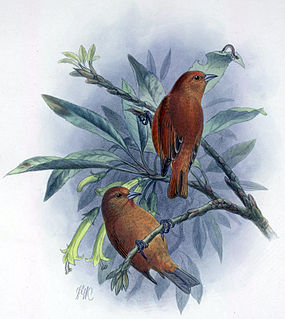
The Oʻahu ʻakepa is an extinct species of ʻakepa that was endemic to the island of Oahu. It was commonly sighted throughout the 19th century. This brick red Hawaiian honeycreeper was found in the mountain peaks in densely forested areas. The females were mostly gray with a tinge of green. The birds had a slight crossbill just like the other Loxops species. It used its crossbill to open up buds in search for nectar and insects for it to eat. Its most common haunts were the ʻōhiʻa and koa forests that were filled with the many flowers and insects that this species liked to eat. The Oʻahu ʻakepa is one of three different species of ʻakepa that were spread by possible weather and migration. The movement of the species stopped causing the species to break into four branches. The first branch was the Hawaiian ʻakepa, a scarlet- red bird that lives only on the Big Island and may be the ancestor of the genus Loxops. Next is the Maui ʻakepa, which was found as fossils on all the islands of Maui Nui, but was historically seen on Maui. It is a grayish-orange bird that was the first of the ʻakepa species to disappear. Then came the Oʻahu ʻakepa, which is a brick red color and was seen till around the 1900s when it became extinct. The last branch was the ‘akeke‘e, a green bird that is only found on the island of Kauai.
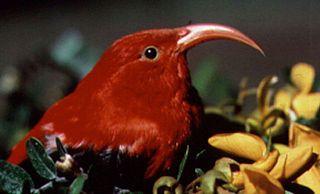
Hawaiian honeycreepers are a group of small, passerine birds endemic to Hawaiʻi. They are closely related to the rosefinches in the genus Carpodacus, but many species have evolved features unlike those present in any other finch. Their great morphological diversity is the result of adaptive radiation in an insular environment. Many have been driven to extinction since the first humans arrived in Hawaii, with extinctions increasing over the last 2 centuries following European discovery of the islands, with habitat destruction and especially invasive species being the main causes.
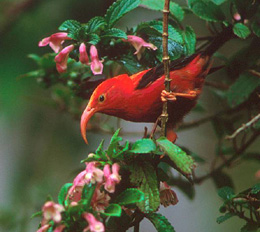
Drepanidini is a tribe of cardueline finches containing the Hawaiian honeycreepers. It was formerly considered one of three Hawaiian honeycreeper tribes, and restricted to the genera Ciridops, Drepanis, Himatione, Melamprosops, and Palmeria, most of which are nectarivores with brightly-colored or boldly-patterned plumage and songs containing nasal squeaks and whistles. However, as these three tribes were each para- or polyphyletic, and as Hawaiian honeycreepers are no longer treated as their own subfamily or family, Drepanidini is now typically used for all Hawaiian honeycreepers.
The greater akialoa group was a set of three species of birds growing up to 19 centimetres (7.5 in) long. Its bill took up to a third of the body length. The group had three species, confined to the Hawaiian Islands of Lanai, Oahu and Kauai respectively. It did not include the much smaller Lesser ʻakialoa, which was considered a full species. The Lanai and Oahu forms are extinct, while there is a remote possibility that the Kauai form survives.
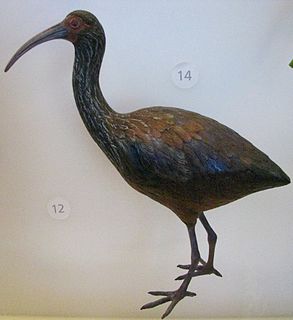
Apteribis is an extinct genus of flightless birds in the ibis subfamily that was endemic to the Hawaiian Islands in the Pacific Ocean.














